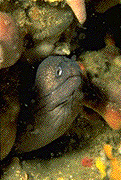| Reticulate moray | |
|---|---|
 | |
| Scientific classification | |
| Kingdom: | Animalia |
| Phylum: | Chordata |
| Class: | Actinopterygii |
| Order: | Anguilliformes |
| Family: | Muraenidae |
| Genus: | Muraena |
| Species: | M. retifera |
| Binomial name | |
| Muraena retifera Goode & T. H. Bean, 1882 | |
The reticulate moray (Muraena retifera) is a moray eel with pharyngeal jaws. It is part of the genus Muraena .
It is native to the southeastern United States, the Bay of Campeche and the Leeward Antilles.
